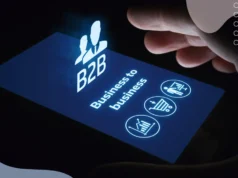
As a business, you have probably heard many people talking about the importance of being on social media. There are even businesses nowadays who trade primarily through social media platforms such as Instagram. With more and more people around the world joining social media networks every day, it makes perfect sense to tap into that market. It doesn’t matter what industry you are in, either. According to TechQuarters, who primarily provide IT support and managed services, it’s just about finding your niche on the platform – they themselves have had success with driving sales through social media platforms.

Why Use Social Media?
As touched upon above, there are a lot of people on social media. In fact, the number of people using social media worldwide has more than doubled in the last 6 years, reaching a whopping 4.48 billion (More than half the global population).
One might be inclined to think that social media is mainly for young people, artists, creatives, etc. But actually all of the top platforms have been designed to be a perfect platform for businesses to market and advertise themselves to audiences. For example, 90% of Instagram users are following at least one brand on the platform; and 80% of Instagram users have said that the platform helps them decide on which product or service to buy – considering Instagram alone has 1 billion monthly actie users, that is some pretty powerful persuasion.
You’re probably already convinced that social media is a valuable tool for your business, however, and you’re actually looking for some tips on how best to drive sales with it. Below are some useful tips to make your social media presence as successful as possible.

1. Find the Right Platforms
There are so many different social media platforms out there, and it can be tempting to try and join them all. But what many businesses fail to understand is that if you try to use them all, you won’t have success with any. Start by researching which social media platforms your target audiences are using, and focus your efforts on them. By narrowing the platforms down, you’ll be able to allocate resources and time better.
2. Interactive Posts
With social media, businesses need to remember that audiences are using it on their free time – i.e. it is a form of entertainment. Therefore, the content you publish on there should be entertaining. Users will see a hard sell from a mile off, and they won’t engage with it. Instead, create content that is interactive. Try offering content that drives engagement – such as users tagging their friends for a chance to win a free product.

3. User-Generated Content
People trust brands that are being represented voluntarily by regular consumers. If you have users on social media who are posting positive things about your brand, that is a big sign that your product or service is doing things right – and people will see that. Whenever users generate positive content about your brand, do not hesitate to share – it will help build your reputation.
4. Shoppable Posts
One of the excellent features of social media is its ability to streamline the customer journey towards actually buying your product or service. Of course, it is very rare that consumers purchase something after a single customer impression, but buy generating shoppable posts – i.e. social media posts where users can literally click through to a checkout basket – will mean that when customers do decide they want to buy something, it is as easy for them as can be.

5. Partner with Influencers
Influencers are a unique tool for marketing that has arisen along with social media. Influencers could have literally a hundred thousand of people following them – and that’s a hundred thousand potential customers. Many businesses partner with influencers. By gifting them products or services, they will advertise your brand to their followers. Influencer partnerships can be incredibly fruitful if you find influencers whose follower base align with your ideal customer profile.
6. Incentivise Referrals
Influencers aren’t the only types of users who can help bring in new potential customers. You can incentivise customers to refer others to your brand. This is usually done by providing a referral code upon purchase of a product or service, which entitles the customer, and whomever they give the code to, to a discount with the brand. This is a good way of getting people to spread the word about your brand.
7. Flash Sales
Sales are a great way to get people who may have been on the fence about purchasing from a brand into actually buying something. A flash sale is one that is both short-lived and short-notice. For instance, a brand might announce a flash sale just a few hours before it starts, and will then only run for perhaps 12-24 hours. This is a way of creating urgency for people who have been considering buying something.
8. Brand-specific Hashtags
Hashtags are a key element of most social media platforms. People can search certain hashtags; you can even follow hashtags, so that they get a feed of posts from people using them, even if you aren’t following those people. A great way of making your brand unique is by creating unique hashtags that are specific to you. If those hashtags become popular, you could have people from all over the world discovering your brand. Brand-specific hashtags are also a great way of collating user-generated content.

9. Stick to your Schedule
The most important thing about social media platforms is that you need to remain on them consistently. There is such as thing as the lifetime of a post – in other words, how long a post remains visible on somebody’s feed. For Instagram, it’s an average of 48 hours on the feed, whereas for Instagram stories, a post’s lifetime is half that time; on Facebook, posts have an average lifetime of just 5 hours, and for Twitter it’s a mere 20 minutes. So what does this mean? It means you can’t rely on a single post, you need to have a schedule of posts, and you need to stick to that schedule. Posting every day, or every 2 days, is generally recommended.
10. Stick to your Branding
You wouldn’t use inconsistent branding on your company website, would you? For some reason, some people don’t think about the branding of a social media account. But the way your Instagram account looks is just as important as how your professional website looks. Everything from your username and URL, to your profile and cover photos should have a common theme; and your posts on various platforms should have a unique and consistent style to them (whilst remaining fresh).










